江苏省扬州市2021年中考专题复习——代词 课件(34张PPT)
文档属性
| 名称 | 江苏省扬州市2021年中考专题复习——代词 课件(34张PPT) |  | |
| 格式 | ppt | ||
| 文件大小 | 255.0KB | ||
| 资源类型 | 教案 | ||
| 版本资源 | 人教新目标(Go for it)版 | ||
| 科目 | 英语 | ||
| 更新时间 | 2021-05-08 15:32:09 | ||
图片预览


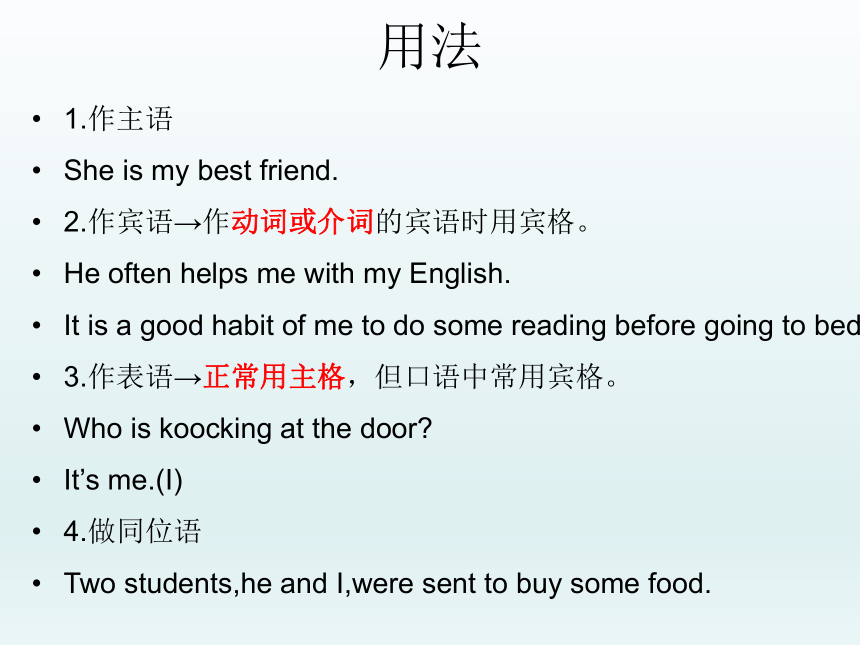
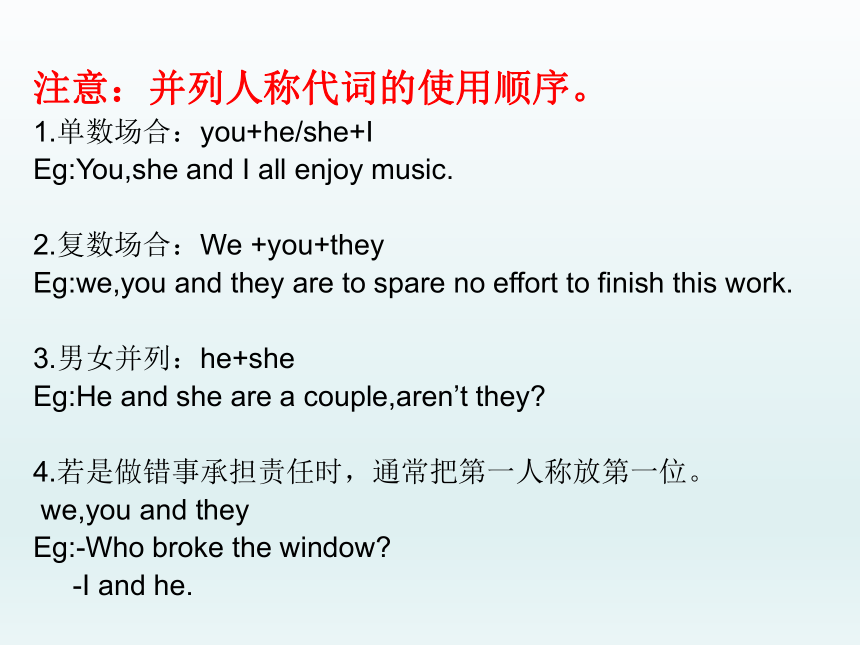

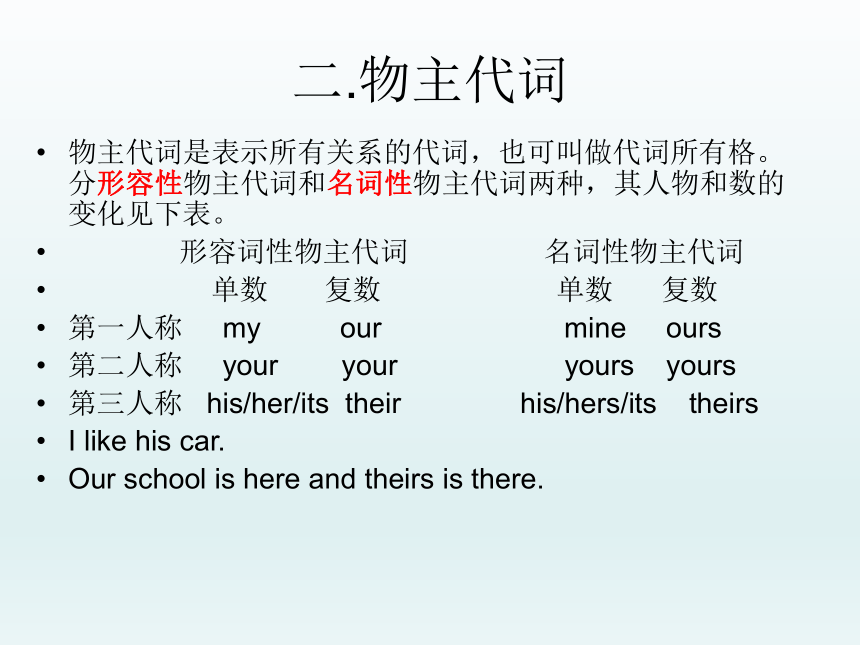
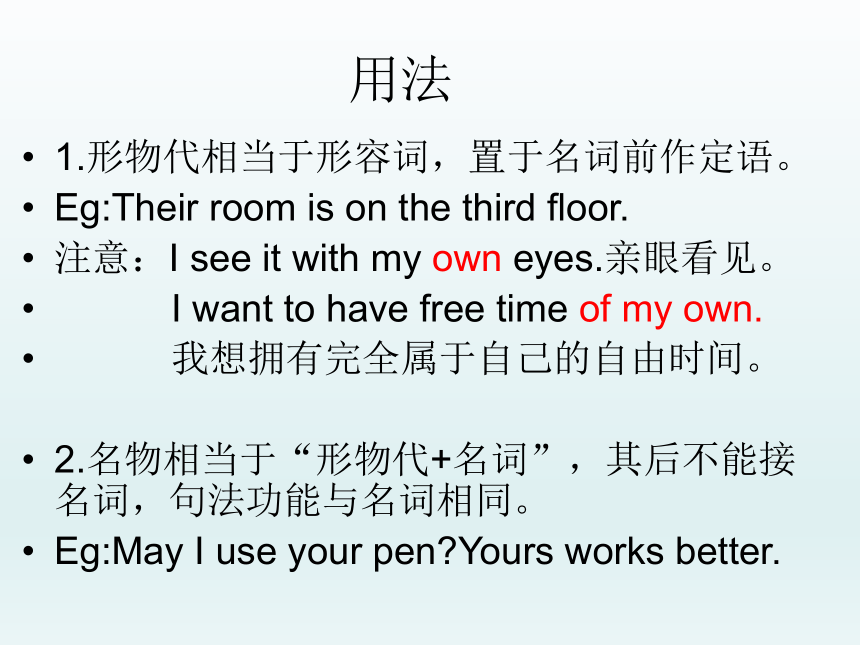
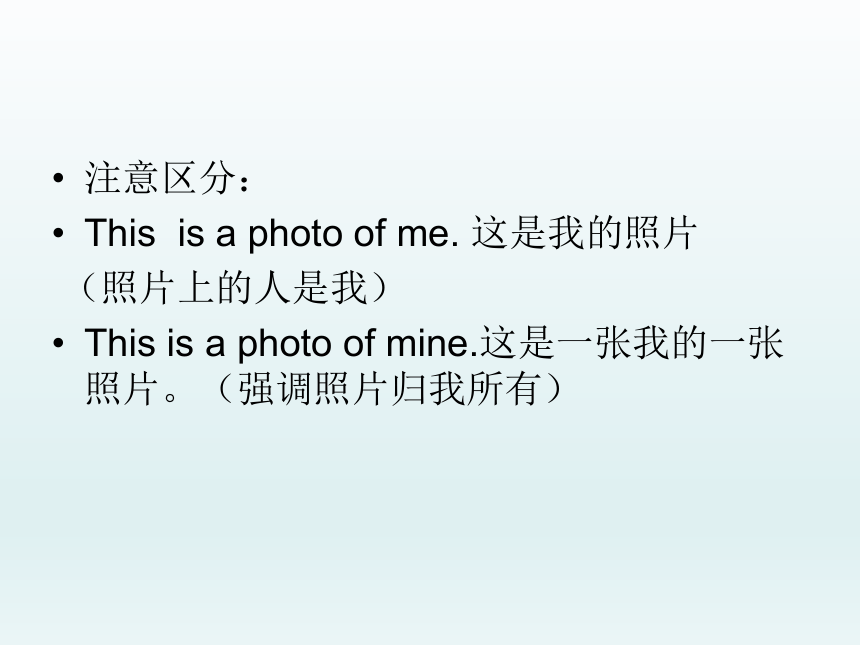

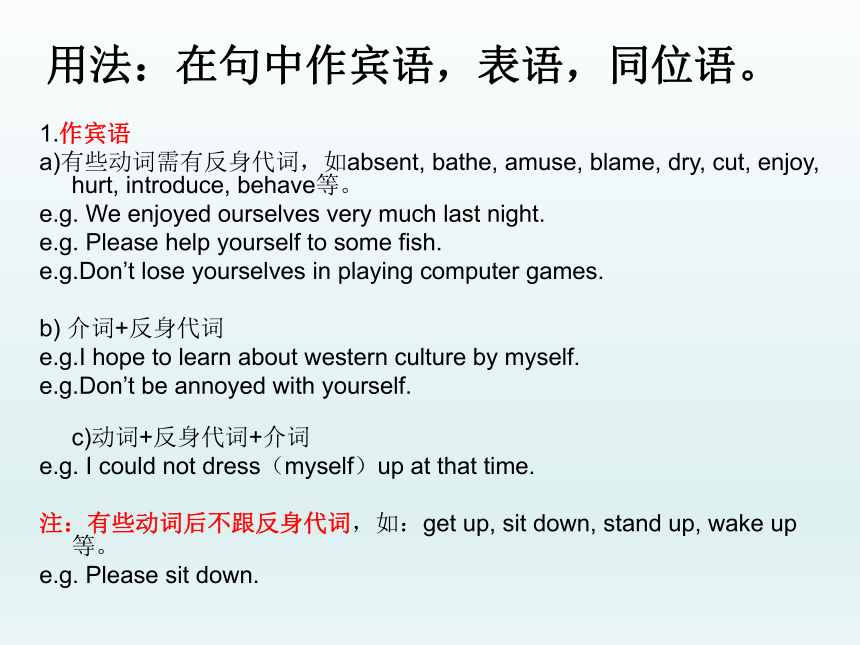

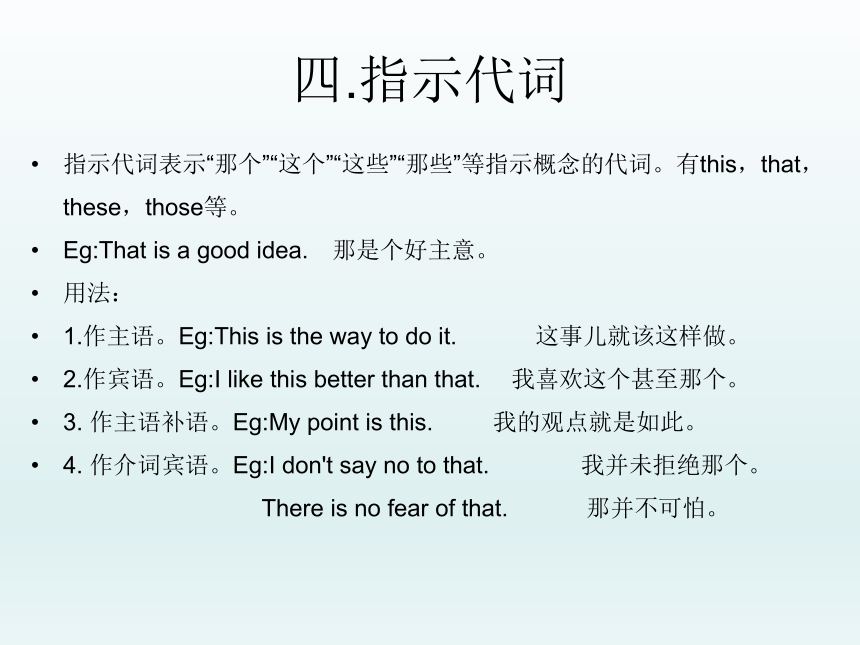
文档简介
(共34张PPT)
代词
代词是代替名词的词类。
大多数代词具有名词和形容词的功能。
按其意义、特征及在句中的作用分为:人称代词、物主代词、指示代词、反身代词、相互代词、疑问代词、关系代词,连接代词和不定代词九种。
中考考察重点:人称,物主,反身。
中考考察难点:不定代词。
一.人称代词
一、人称代词是表示“我”、“你”、“他”、“她”、“它”、“我们”、“你们”、“他们”的词。指人,也可指物。有人称、数和格的变化。
主单
主复
宾单
宾复
第一人称
I
We
me
us
第二人称
you
you
you
you
第三人称he/she/It
they
him/her/it
them
用法
1.作主语
She
is
my
best
friend.
2.作宾语→作动词或介词的宾语时用宾格。
He
often
helps
me
with
my
English.
It
is
a
good
habit
of
me
to
do
some
reading
before
going
to
bed.
3.作表语→正常用主格,但口语中常用宾格。
Who
is
koocking
at
the
door?
It’s
me.(I)
4.做同位语
Two
students,he
and
I,were
sent
to
buy
some
food.
注意:并列人称代词的使用顺序。
1.单数场合:you+he/she+I
Eg:You,she
and
I
all
enjoy
music.
2.复数场合:We
+you+they
Eg:we,you
and
they
are
to
spare
no
effort
to
finish
this
work.
3.男女并列:he+she
Eg:He
and
she
are
a
couple,aren’t
they?
4.若是做错事承担责任时,通常把第一人称放第一位。
we,you
and
they
Eg:-Who
broke
the
window?
-I
and
he.
注意:it的用法。
1.指代上文提过的事物。
e.g:You
have
saved
my
life,I
shall
never
forget
it.
2.指代时间,地点,距离,天气,温度等。
3.指代婴儿或不知身份,性别的人。
e.g:-Who
is
dancing
in
the
classroom?
-It
must
be
Lily.
4.作形式主语或形式宾语。
→It
用来代替不定式,动名词,从句等作形式主语或形式宾语,而把真正的主语或宾语置于句末。
e.g:It
is
necessary
for
us
to
carry
on
with
this
task.(形式主语)
It
+be+过去分词+that
e.g
It
is
said
that/believed
that...
It+be
+名词词组+doing
sth
e.g
It
is
no
good
telling
lies.
Did
you
find
it
very
interesting
to
play
volleyball?(形式宾语)
二.物主代词
物主代词是表示所有关系的代词,也可叫做代词所有格。分形容性物主代词和名词性物主代词两种,其人物和数的变化见下表。
形容词性物主代词
名词性物主代词
单数
复数
单数
复数
第一人称
my
our
mine
ours
第二人称
your
your
yours
yours
第三人称
his/her/its
their
his/hers/its
theirs
I
like
his
car.
Our
school
is
here
and
theirs
is
there.
用法
1.形物代相当于形容词,置于名词前作定语。
Eg:Their
room
is
on
the
third
floor.
注意:I
see
it
with
my
own
eyes.亲眼看见。
I
want
to
have
free
time
of
my
own.
我想拥有完全属于自己的自由时间。
2.名物相当于“形物代+名词”,其后不能接名词,句法功能与名词相同。
Eg:May
I
use
your
pen?Yours
works
better.
注意区分:
This
is
a
photo
of
me.
这是我的照片
(照片上的人是我)
This
is
a
photo
of
mine.这是一张我的一张照片。(强调照片归我所有)
三.反身代词
概念:表示动作回执到其执行者本身,用以加强语气。
反身代词与它所指代的名词或代词形成互指关系,
在人称,数和性别上保持一致。
myself
ourselves
yourself
yourselves
herself
/
himself
/
itself
themselves
oneself
e.g.
She
was
talking
to
herself.
巧记方法:第一人称,第二人称→形物代+self
第三人称→宾格+self
用法:在句中作宾语,表语,同位语。
1.作宾语
a)有些动词需有反身代词,如absent,
bathe,
amuse,
blame,
dry,
cut,
enjoy,
hurt,
introduce,
behave等。
e.g.
We
enjoyed
ourselves
very
much
last
night.
e.g.
Please
help
yourself
to
some
fish.
e.g.Don’t
lose
yourselves
in
playing
computer
games.
b)
介词+反身代词
e.g.I
hope
to
learn
about
western
culture
by
myself.
e.g.Don’t
be
annoyed
with
yourself.
c)动词+反身代词+介词
e.g.
I
could
not
dress(myself)up
at
that
time.
注:有些动词后不跟反身代词,如:get
up,
sit
down,
stand
up,
wake
up等。
e.g.
Please
sit
down.
2.
用作表语,在be,feel,look,seem等系动词后作表语,表示身体或精神所处的状态。
e.g.I
am
not
myself
today.
我今天不舒服。
After
a
few
days
of
rest,he
was
more
himself
again.身体好多了。
3.
用作同位语,作主语或宾语的同位语,加强语气,表示“亲自,本身,本人”。
e.g.The
thing
itself
is
not
important.
事情本身并不重要。
I
spoke
to
the
headmaster
himself.对校长本人讲。
注意:反身代词可用来强调主语本身,但不能单独作主语。
e.g.正确:I
myself
will
do
it.
I
will
do
it
myself.→错误:Myself
will
do
it.
4.
在不强调的情况下,but,
except,
for
等介词后宾语用反身代词或人称代词宾格均可
如:No
one
but
myself(me)is
hurt.
反身代词可用来强调主语本身,不能单独作主语。
但在and,
or,
nor连接的并列主语中,可用在另一个名词后并列作主语,特别是myself
作主语。例如:Charles
and
myself
saw
it.
查尔斯和我看见了这件事。
5.固定搭配。
Come
to
oneself
恢复知觉
learn
by
oneself自学
Talk
to
oneself
自言自语
teach
oneself
自学
By
oneself
独自
for
oneself
亲自
of
oneself
自然地,自发地(He
will
wake
up
of
himself.自己醒)
四.指示代词
指示代词表示“那个”“这个”“这些”“那些”等指示概念的代词。有this,that,these,those等。
Eg:That
is
a
good
idea. 那是个好主意。
用法:
1.作主语。Eg:This
is
the
way
to
do
it.
这事儿就该这样做。
2.作宾语。Eg:I
like
this
better
than
that.
我喜欢这个甚至那个。
3.
作主语补语。Eg:My
point
is
this.
我的观点就是如此。
4.
作介词宾语。Eg:I
don't
say
no
to
that.
我并未拒绝那个。
There
is
no
fear
of
that.
那并不可怕。
用法
1.指示代词在作主语时可指物也可指人,但作其他句子成分时只能指物,不能指人。
例如
(对)That
is
my
teacher. 那是我的老师。(that作主语,指人)
(对)He
is
going
to
marry
this
girl. 他要和这个姑娘结婚。(this作限定词)
(错)He
is
going
to
marry
this. (this作宾语时不能指人)
(对)I
bought
this. 我买这个。(this指物,可作宾语)
2.this/these
往往指时间或者空间上比较近的人/物
that/those
往往指在时间或空间上比较远的人/物
3.英国人打电话的时候,this
指自己,that指别人
4.that
既可以指代不可数名词,又可以指代单数可数名词,指代单数可数名词时等于the
one
those
只能指代可数名词复数,相当于the
ones
5.That和those可作定语从句的先行词,但this和
these不能,同时,在作先行词时,只有those可指人,试比较:
(对)
He
admired
that
which
looked
beautiful. 他赞赏外表漂亮的东西。
(对)
He
admired
those
who
looked
beautiful.
他赞赏那些外表漂亮的人(those指人)
(错)
He
admired
that
who
danced
well. (that作宾语时不能指人)
(对)
He
admired
those
who
danced
well. 他赞赏跳舞好的人。(those指人)
(对)
He
admired
those
which
looked
beautiful.
他赞赏那些外表漂亮的东西。(those指物)
五.相互代词
相互关系的代词叫相互代词
主要有each
other
和one
another两组
each
other用于两者之间
one
another用于三者或三者向上。
在现代英语中,each
other也可用于三者或以上。
e.g.They
love
each
other.
用法
1.
作动词宾语.(以相互代词作宾语的句子不能变成被动语态)
Eg:People
should
love
one
another.
人们应当彼此相爱。
2.
作介词宾语.
Eg:They
shook
hands
with
each
other.
3.作定语.相互代词的所有格作定语,表示所属关系。
Eg:They
usually
meet
in
one
another’s
homes.
We
said
hello
to
one
another’s/each
other’s
family.
注意:传统语法认为,相互关系存在于两个人或物之间用each
other,
存在于两个以上人和物之间用one
another。现代英语中,两组词交替使用的实例也很多。
Eg:He
put
all
the
books
beside
each
other/one
another.
他把所有书并列摆放起来。
Usually
these
small
groups
were
independent
of
each
other.
这些小团体通常是相互独立的。
?
六.不定代词
用法
一.some
和any
(高频)
1.
可与复数名词及不可数名词连用。一般来说,some用于肯定句,any用于否定和疑问句。
Eg:I
gave
him
some
tea.
There
isn’t
any
water
in
the
bottle.
Are
there
any
books
on
the
desk?
2.注意:
a.肯定疑问句中:说话人认为对方的答案会是肯定的,或期望得到肯定回答时。
Would/Could
you
like/give…….句式中,表委婉请求或建议。
Eg:Would
you
like
some
coffee?
喝咖啡吗?
b.在条件状语从句中表示确定的意义时。
eg:If
you
need
some
help,let
me
know.
需要帮助,跟我说。
c.some位于主语部分。
Eg:Some
students
haven't
been
there
before.
有些学生没去过那儿。
d.当否定的是整体中的部分时,some可用于否定句。例如:
I
haven‘t
heard
from
some
of
my
old
friends
these
years.
3.
当作"某一"解时,也可与单数名词连用。(=
a
certain)
You
will
be
sorry
for
this
some
day.
总有一天,你会为此后悔的。
A
certain
(some)
person
has
seen
you
break
the
rule.
有些人不同意你的看法。
4.
any
多用于否定句和疑问句和条件状语从句中,但当句中含有任何的意思时,any可用于肯定句。
If
you
have
any
questions,please
put
up
your
hand.
5.”some/any
of+….”结构作主语时,谓语动词的单复数需要根据of后面的名词的单复数而定。
Eg:Some
of
the
food
has
gone
sour.
Some
of
the
teachers
agree
to
go
there
by
bus.
二.all
和both(高频)
1.all
的主谓一致:all的单复数由它所修饰或指代的名词单复数决定。
e.g.All
goes
well.
一切进展得很好。
注:
a.
all
通常不与可数名词单数连用,如:不说
all
the
book,
而说the
whole
book,但all可与表时间的可数名词单数连用
如
all
day,all
night,all
the
year;
但习惯上不说
all
hour,all
century。
b.
all还可以与一些特殊的单数名词连用
如all
the
city,all
my
life,all
the
way
all与not连用表示部分否定,全部否定用none。
2.both都,指两者,both
与复数动词连用,但
both…
and…可与单数名词连用。
3.both,
all
都可作同位语,其位置在行为动词前,
be
动词,系动词,助动词,情态动词之后。
但如果助动词或情态动词后面的实义动词省去,则位于助动词或情态动词之前。
Eg:
Who
can
speak
Japanese? 谁能讲日本话?
We
both(all)can.
我们都不会。
Do
you
all
agree
to
this
plan?
Yes,we
all
do.
三.One(高频)
1.用来代替单数可数名词,表泛指,ones代替复数可数名词。
Eg:I
have
been
looking
for
a
map,but
I
can’t
find
one.
2.可指代不特定的人,表示“人,一个人,人们”。
Eg:One
should
do
his
best
at
all
times.
3.the
one
表示特指的“一个人”或“一个事物”
the
ones
表示特指
复数
也就是说可以和the以及四个指示代词连用,表特指,也可用形容词来修饰
Eg:I
do
not
like
that
cell
phone,the
one
you
just
showed
me.
I
have
an
old
bike
and
she
has
a
new
one.
4.
One,it
和that的区别
one代替单数可数名词,表示泛指,that和it
表示特指。
that与所指名词为同类,但不是同一个,可加可数名词单数/不可数名词,相当于
the+名词
而it
与所指名词为同一个。
例如:
I
can‘t
find
my
hat.
I
think
I
must
buy
one.(同类不同物)
The
hat
you
bought
is
bigger
than
that
I
bought.(同类但不同个)
I
can‘t
find
my
hat.
I
don’
t
know
where
I
put
it.(
同一物)
注意:one只能代替可数名词,如果代替的是特指的不可数名词,应用that。
I
am
moving
to
the
countryside
because
the
air
there
is
much
fresher
that
that
in
the
city.
四.either/neither(高频)
1.either表示两者中任一个,作主语时,谓语动词常用单数,后可接of短语。
e.g.We
don’t
care
much
for
what
to
eat.Either
of
the
two
will
do.
2.neither表示两者都不,作主语时,谓语常用单数形式,其后可接of短语。
e.g.Neither
of
them
wants
to
speak
to
him
about
this
matter.
注:neither的反义是both
e.g.Both
of
them
know
the
news.
五.each和every
each:强调个体---
作主语,宾语,定语同位语
---
可与of搭配
every:强调整体---作定语
---
不可与of搭配
1)each指代或修饰单数可数名词,强调个体,多用于两者或两者以上。作主语时,谓语动词用单数。
e.g.Each
of
them
knows
the
whole
thing.
We
each
have
a
book.
There
are
trees
on
each
side
of
the
road.
2)every修饰单数可数名词,强调整体,多用于三者或三者以上。修饰名词作主语时,谓语动词用单数。
e.g.Every
student
will
take
part
in
the
research.
Every
man
is
not
honest.(every与not连用,表示部分否定)
并非每个人.....
表示“每隔...
每...”要用“every+基数词+名词”
every
two
weeks
每两周
六、none
,
no
one
,
nothing
none
1)可跟of,具体指什么人与物
2)谓语动词用单数或复数
3)暗示一种数量→一个也没有
用来回答how
many/much或含有any+n.引起的疑问句
e.g.None
of
us
have/has
seen
him.
How
many
students
are
there
in
the
room?---None.
Is
there
any
water
in
the
cup?---None.
no
one
1)指代人,但不具体指什么人,不可跟of
2)谓语动词用单数
3)表示什么人也没有→回答who,以及含anyone,anybody引起的疑问句
e.g.No
one
likes
a
person
with
bad
manners.
---Who's
in
the
room?---No
one.
---Is
there
anyone
in
the
room?---No
one.
nothing
1)指物
2)谓语用单数
3)回答含anything的一般疑问句及what引起的特殊疑问句
e.g.---What's
in
the
box?---Nothing.
---Is
there
anything
in
the
sky?---Nothing.
---Can
you
see
anything
without
glasses?---Nothing.
no
one与none好辩分。具体人,物把none填。
不知何人与何物,no
one,nothing是一路
no
one指人,nothing指物,保你不会出错误。
七、other,the
other,others和the
others(高频)
1.other只能做定语,加可数或不可数名词
e.g.
I
suggested
a
camping
holiday,but
Jane
had
other
ideas.
They
have
no
other
place
to
go.
注:other前有the,some,any,no,each,every,one以及形容词性物主代词时,other+单数可数名词。
2.the
other“另一个、其他的”
Hold
it
in
this
hand,not
the
other
hand.
3.others泛指别的人或物,=other+复数可数名词
“some....others...”
Some
people
like
tea,others
like
coffee
and
others
like
milk.
4.the
others特指“其余所有人或物”=“the
other
+复数可数名词”
e.g.Three
of
us
remian
here
and
all
the
others
go
to
the
next
room.
=the
other
people
5.another“三者或三者以上的任何一个”,一般修饰或代替单数可数名词。
“another
+
数词+
复数可数名词”
=
“数词+more/other+复数可数名词”
----Could
we
see
each
other
at
9
o'clock
tomorrow
m,orning?
----Sorry,let's
make
it
another
time.
They
need
another
two
hours
to
finish
this
work.
注:
1)another没有复数形式,不能与冠词,指示代词,物主代词等连用
2)another常用在数词的前面
one...the
others表示确定数目中的“
一个...,其余的...”
some...others...
主要用来描述有很多人或事物的情况,“一些...,另一些...”
注意:
the
other+day/night
等时间名词时,表示“几天前”“几天前的一个晚上”等
6.many,much(高频)
1)many+可数名词,much+不可数名词
2)too
many,too
much,much
too,(many
too×)
7.few,a
few,little,a
little区别
8.复合不定代词(单数,形容词前)
some
any
no
every
something
anything
nothing
everything
somebody
--
--
--
someone
--
--
--
somewhere
--
--
--
注意:
Is
everyone
here
today?
I
have
read
every
one
of
his
books.
他的每本书我都读过了
something构成的习惯用法
something
like
大约,左右
something
of
有几分
or
something
(放在名词后,表示没有把握)诸如此类,或什么的
八、疑问代词
who,what,which,whose
1.who,whom的用法→指人,其中,who作主语,宾语,表语;whom只能做宾语
---Who
is
that
man
over
there?
---He
is
my
uncle.
Who/Whom
are
you
talking
to?
To
whom
did
you
speak
on
the
playground?
2.whose用法→既可置于名词前作定语,也可单独使用作主语和表语
Whose
dictionary
is
this?
They
are
good
at
math,but
whose
is
best?
Whose
are
those
flowers?
3.which的用法→哪一个哪一些,指人或物,在句中作主语,宾语和定语(范围)
Which
do
you
like
best,tea,coffee
or
juice?---Coffee
4.What的用法→指物,在句中作主语,宾语,表语和定语
What
makes
you
love
your
hometown
so
much?
What
are
your
reasons
for
leaving?
5.what的习惯用法
1)What
are
you?=
What
do
you
do?=What's
your
job?
2)what's
sb.like?
&
what
do/does
sb.look
like?
What's
he
like?---He
is
hardworking.
What
does
he
look
like?---He
is
tall
and
strong.
3)What's
the
weather
like?
4)what..for...?或what
for?用于询问原因和目的
---I
am
going
the
supermarket.
---What
for?We
still
have
enough
food
in
the
fridge.
5)what
if..?表示假设,建议,征求意见或疑虑
What
if
it
rains
while
we
are
on
the
way?
6)what
about征求意见或询问对方情况
What
about
going
on
a
trip
to
Shanghai?
九.连接代词→用来指链接主语从句,宾语从句,表语从句等的代词
1.表示疑问的连接代词
→引导名词性从句,有疑问意义,在句中作主语,宾语,表语和定语等
Who
will
teach
us
physics
next
term
hasn't
decided
yet.(主)
Could
you
tell
me
which
gate
we
have
to
go
to?(定)
He
didn't
tell
me
whose
computer
this
was.(定)
I
have
no
idea
whomever
I
should
invite
to
get-together.(宾)
2.表示陈述的连接代词
→引导名词性从句,没有疑问意义,在句中作主语,宾语,定语等
I
won't
believe
whoever
cheats
me.(宾从中作主语)
I
will
tell
you
what
we
are
planning
to
do
next
Monday.(宾从中作宾语)
I
will
walk
around
and
collect
whosever
homework
has
been
well
done.(宾从中作定语)
十、关系代词that,which,who,whom,whose,as等→用来引导定语从句,且在定从中作主语,宾语,表语或定语的代词,代表句子所修饰的成分
1.I
have
been
to
the
city
twice
that
you
just
visited.
2.You're
the
only
one
whose
advice
he
might
listen
to.
3.Can
you
tell
me
the
reason
for
which
the
car
broke
down?
代词
代词是代替名词的词类。
大多数代词具有名词和形容词的功能。
按其意义、特征及在句中的作用分为:人称代词、物主代词、指示代词、反身代词、相互代词、疑问代词、关系代词,连接代词和不定代词九种。
中考考察重点:人称,物主,反身。
中考考察难点:不定代词。
一.人称代词
一、人称代词是表示“我”、“你”、“他”、“她”、“它”、“我们”、“你们”、“他们”的词。指人,也可指物。有人称、数和格的变化。
主单
主复
宾单
宾复
第一人称
I
We
me
us
第二人称
you
you
you
you
第三人称he/she/It
they
him/her/it
them
用法
1.作主语
She
is
my
best
friend.
2.作宾语→作动词或介词的宾语时用宾格。
He
often
helps
me
with
my
English.
It
is
a
good
habit
of
me
to
do
some
reading
before
going
to
bed.
3.作表语→正常用主格,但口语中常用宾格。
Who
is
koocking
at
the
door?
It’s
me.(I)
4.做同位语
Two
students,he
and
I,were
sent
to
buy
some
food.
注意:并列人称代词的使用顺序。
1.单数场合:you+he/she+I
Eg:You,she
and
I
all
enjoy
music.
2.复数场合:We
+you+they
Eg:we,you
and
they
are
to
spare
no
effort
to
finish
this
work.
3.男女并列:he+she
Eg:He
and
she
are
a
couple,aren’t
they?
4.若是做错事承担责任时,通常把第一人称放第一位。
we,you
and
they
Eg:-Who
broke
the
window?
-I
and
he.
注意:it的用法。
1.指代上文提过的事物。
e.g:You
have
saved
my
life,I
shall
never
forget
it.
2.指代时间,地点,距离,天气,温度等。
3.指代婴儿或不知身份,性别的人。
e.g:-Who
is
dancing
in
the
classroom?
-It
must
be
Lily.
4.作形式主语或形式宾语。
→It
用来代替不定式,动名词,从句等作形式主语或形式宾语,而把真正的主语或宾语置于句末。
e.g:It
is
necessary
for
us
to
carry
on
with
this
task.(形式主语)
It
+be+过去分词+that
e.g
It
is
said
that/believed
that...
It+be
+名词词组+doing
sth
e.g
It
is
no
good
telling
lies.
Did
you
find
it
very
interesting
to
play
volleyball?(形式宾语)
二.物主代词
物主代词是表示所有关系的代词,也可叫做代词所有格。分形容性物主代词和名词性物主代词两种,其人物和数的变化见下表。
形容词性物主代词
名词性物主代词
单数
复数
单数
复数
第一人称
my
our
mine
ours
第二人称
your
your
yours
yours
第三人称
his/her/its
their
his/hers/its
theirs
I
like
his
car.
Our
school
is
here
and
theirs
is
there.
用法
1.形物代相当于形容词,置于名词前作定语。
Eg:Their
room
is
on
the
third
floor.
注意:I
see
it
with
my
own
eyes.亲眼看见。
I
want
to
have
free
time
of
my
own.
我想拥有完全属于自己的自由时间。
2.名物相当于“形物代+名词”,其后不能接名词,句法功能与名词相同。
Eg:May
I
use
your
pen?Yours
works
better.
注意区分:
This
is
a
photo
of
me.
这是我的照片
(照片上的人是我)
This
is
a
photo
of
mine.这是一张我的一张照片。(强调照片归我所有)
三.反身代词
概念:表示动作回执到其执行者本身,用以加强语气。
反身代词与它所指代的名词或代词形成互指关系,
在人称,数和性别上保持一致。
myself
ourselves
yourself
yourselves
herself
/
himself
/
itself
themselves
oneself
e.g.
She
was
talking
to
herself.
巧记方法:第一人称,第二人称→形物代+self
第三人称→宾格+self
用法:在句中作宾语,表语,同位语。
1.作宾语
a)有些动词需有反身代词,如absent,
bathe,
amuse,
blame,
dry,
cut,
enjoy,
hurt,
introduce,
behave等。
e.g.
We
enjoyed
ourselves
very
much
last
night.
e.g.
Please
help
yourself
to
some
fish.
e.g.Don’t
lose
yourselves
in
playing
computer
games.
b)
介词+反身代词
e.g.I
hope
to
learn
about
western
culture
by
myself.
e.g.Don’t
be
annoyed
with
yourself.
c)动词+反身代词+介词
e.g.
I
could
not
dress(myself)up
at
that
time.
注:有些动词后不跟反身代词,如:get
up,
sit
down,
stand
up,
wake
up等。
e.g.
Please
sit
down.
2.
用作表语,在be,feel,look,seem等系动词后作表语,表示身体或精神所处的状态。
e.g.I
am
not
myself
today.
我今天不舒服。
After
a
few
days
of
rest,he
was
more
himself
again.身体好多了。
3.
用作同位语,作主语或宾语的同位语,加强语气,表示“亲自,本身,本人”。
e.g.The
thing
itself
is
not
important.
事情本身并不重要。
I
spoke
to
the
headmaster
himself.对校长本人讲。
注意:反身代词可用来强调主语本身,但不能单独作主语。
e.g.正确:I
myself
will
do
it.
I
will
do
it
myself.→错误:Myself
will
do
it.
4.
在不强调的情况下,but,
except,
for
等介词后宾语用反身代词或人称代词宾格均可
如:No
one
but
myself(me)is
hurt.
反身代词可用来强调主语本身,不能单独作主语。
但在and,
or,
nor连接的并列主语中,可用在另一个名词后并列作主语,特别是myself
作主语。例如:Charles
and
myself
saw
it.
查尔斯和我看见了这件事。
5.固定搭配。
Come
to
oneself
恢复知觉
learn
by
oneself自学
Talk
to
oneself
自言自语
teach
oneself
自学
By
oneself
独自
for
oneself
亲自
of
oneself
自然地,自发地(He
will
wake
up
of
himself.自己醒)
四.指示代词
指示代词表示“那个”“这个”“这些”“那些”等指示概念的代词。有this,that,these,those等。
Eg:That
is
a
good
idea. 那是个好主意。
用法:
1.作主语。Eg:This
is
the
way
to
do
it.
这事儿就该这样做。
2.作宾语。Eg:I
like
this
better
than
that.
我喜欢这个甚至那个。
3.
作主语补语。Eg:My
point
is
this.
我的观点就是如此。
4.
作介词宾语。Eg:I
don't
say
no
to
that.
我并未拒绝那个。
There
is
no
fear
of
that.
那并不可怕。
用法
1.指示代词在作主语时可指物也可指人,但作其他句子成分时只能指物,不能指人。
例如
(对)That
is
my
teacher. 那是我的老师。(that作主语,指人)
(对)He
is
going
to
marry
this
girl. 他要和这个姑娘结婚。(this作限定词)
(错)He
is
going
to
marry
this. (this作宾语时不能指人)
(对)I
bought
this. 我买这个。(this指物,可作宾语)
2.this/these
往往指时间或者空间上比较近的人/物
that/those
往往指在时间或空间上比较远的人/物
3.英国人打电话的时候,this
指自己,that指别人
4.that
既可以指代不可数名词,又可以指代单数可数名词,指代单数可数名词时等于the
one
those
只能指代可数名词复数,相当于the
ones
5.That和those可作定语从句的先行词,但this和
these不能,同时,在作先行词时,只有those可指人,试比较:
(对)
He
admired
that
which
looked
beautiful. 他赞赏外表漂亮的东西。
(对)
He
admired
those
who
looked
beautiful.
他赞赏那些外表漂亮的人(those指人)
(错)
He
admired
that
who
danced
well. (that作宾语时不能指人)
(对)
He
admired
those
who
danced
well. 他赞赏跳舞好的人。(those指人)
(对)
He
admired
those
which
looked
beautiful.
他赞赏那些外表漂亮的东西。(those指物)
五.相互代词
相互关系的代词叫相互代词
主要有each
other
和one
another两组
each
other用于两者之间
one
another用于三者或三者向上。
在现代英语中,each
other也可用于三者或以上。
e.g.They
love
each
other.
用法
1.
作动词宾语.(以相互代词作宾语的句子不能变成被动语态)
Eg:People
should
love
one
another.
人们应当彼此相爱。
2.
作介词宾语.
Eg:They
shook
hands
with
each
other.
3.作定语.相互代词的所有格作定语,表示所属关系。
Eg:They
usually
meet
in
one
another’s
homes.
We
said
hello
to
one
another’s/each
other’s
family.
注意:传统语法认为,相互关系存在于两个人或物之间用each
other,
存在于两个以上人和物之间用one
another。现代英语中,两组词交替使用的实例也很多。
Eg:He
put
all
the
books
beside
each
other/one
another.
他把所有书并列摆放起来。
Usually
these
small
groups
were
independent
of
each
other.
这些小团体通常是相互独立的。
?
六.不定代词
用法
一.some
和any
(高频)
1.
可与复数名词及不可数名词连用。一般来说,some用于肯定句,any用于否定和疑问句。
Eg:I
gave
him
some
tea.
There
isn’t
any
water
in
the
bottle.
Are
there
any
books
on
the
desk?
2.注意:
a.肯定疑问句中:说话人认为对方的答案会是肯定的,或期望得到肯定回答时。
Would/Could
you
like/give…….句式中,表委婉请求或建议。
Eg:Would
you
like
some
coffee?
喝咖啡吗?
b.在条件状语从句中表示确定的意义时。
eg:If
you
need
some
help,let
me
know.
需要帮助,跟我说。
c.some位于主语部分。
Eg:Some
students
haven't
been
there
before.
有些学生没去过那儿。
d.当否定的是整体中的部分时,some可用于否定句。例如:
I
haven‘t
heard
from
some
of
my
old
friends
these
years.
3.
当作"某一"解时,也可与单数名词连用。(=
a
certain)
You
will
be
sorry
for
this
some
day.
总有一天,你会为此后悔的。
A
certain
(some)
person
has
seen
you
break
the
rule.
有些人不同意你的看法。
4.
any
多用于否定句和疑问句和条件状语从句中,但当句中含有任何的意思时,any可用于肯定句。
If
you
have
any
questions,please
put
up
your
hand.
5.”some/any
of+….”结构作主语时,谓语动词的单复数需要根据of后面的名词的单复数而定。
Eg:Some
of
the
food
has
gone
sour.
Some
of
the
teachers
agree
to
go
there
by
bus.
二.all
和both(高频)
1.all
的主谓一致:all的单复数由它所修饰或指代的名词单复数决定。
e.g.All
goes
well.
一切进展得很好。
注:
a.
all
通常不与可数名词单数连用,如:不说
all
the
book,
而说the
whole
book,但all可与表时间的可数名词单数连用
如
all
day,all
night,all
the
year;
但习惯上不说
all
hour,all
century。
b.
all还可以与一些特殊的单数名词连用
如all
the
city,all
my
life,all
the
way
all与not连用表示部分否定,全部否定用none。
2.both都,指两者,both
与复数动词连用,但
both…
and…可与单数名词连用。
3.both,
all
都可作同位语,其位置在行为动词前,
be
动词,系动词,助动词,情态动词之后。
但如果助动词或情态动词后面的实义动词省去,则位于助动词或情态动词之前。
Eg:
Who
can
speak
Japanese? 谁能讲日本话?
We
both(all)can.
我们都不会。
Do
you
all
agree
to
this
plan?
Yes,we
all
do.
三.One(高频)
1.用来代替单数可数名词,表泛指,ones代替复数可数名词。
Eg:I
have
been
looking
for
a
map,but
I
can’t
find
one.
2.可指代不特定的人,表示“人,一个人,人们”。
Eg:One
should
do
his
best
at
all
times.
3.the
one
表示特指的“一个人”或“一个事物”
the
ones
表示特指
复数
也就是说可以和the以及四个指示代词连用,表特指,也可用形容词来修饰
Eg:I
do
not
like
that
cell
phone,the
one
you
just
showed
me.
I
have
an
old
bike
and
she
has
a
new
one.
4.
One,it
和that的区别
one代替单数可数名词,表示泛指,that和it
表示特指。
that与所指名词为同类,但不是同一个,可加可数名词单数/不可数名词,相当于
the+名词
而it
与所指名词为同一个。
例如:
I
can‘t
find
my
hat.
I
think
I
must
buy
one.(同类不同物)
The
hat
you
bought
is
bigger
than
that
I
bought.(同类但不同个)
I
can‘t
find
my
hat.
I
don’
t
know
where
I
put
it.(
同一物)
注意:one只能代替可数名词,如果代替的是特指的不可数名词,应用that。
I
am
moving
to
the
countryside
because
the
air
there
is
much
fresher
that
that
in
the
city.
四.either/neither(高频)
1.either表示两者中任一个,作主语时,谓语动词常用单数,后可接of短语。
e.g.We
don’t
care
much
for
what
to
eat.Either
of
the
two
will
do.
2.neither表示两者都不,作主语时,谓语常用单数形式,其后可接of短语。
e.g.Neither
of
them
wants
to
speak
to
him
about
this
matter.
注:neither的反义是both
e.g.Both
of
them
know
the
news.
五.each和every
each:强调个体---
作主语,宾语,定语同位语
---
可与of搭配
every:强调整体---作定语
---
不可与of搭配
1)each指代或修饰单数可数名词,强调个体,多用于两者或两者以上。作主语时,谓语动词用单数。
e.g.Each
of
them
knows
the
whole
thing.
We
each
have
a
book.
There
are
trees
on
each
side
of
the
road.
2)every修饰单数可数名词,强调整体,多用于三者或三者以上。修饰名词作主语时,谓语动词用单数。
e.g.Every
student
will
take
part
in
the
research.
Every
man
is
not
honest.(every与not连用,表示部分否定)
并非每个人.....
表示“每隔...
每...”要用“every+基数词+名词”
every
two
weeks
每两周
六、none
,
no
one
,
nothing
none
1)可跟of,具体指什么人与物
2)谓语动词用单数或复数
3)暗示一种数量→一个也没有
用来回答how
many/much或含有any+n.引起的疑问句
e.g.None
of
us
have/has
seen
him.
How
many
students
are
there
in
the
room?---None.
Is
there
any
water
in
the
cup?---None.
no
one
1)指代人,但不具体指什么人,不可跟of
2)谓语动词用单数
3)表示什么人也没有→回答who,以及含anyone,anybody引起的疑问句
e.g.No
one
likes
a
person
with
bad
manners.
---Who's
in
the
room?---No
one.
---Is
there
anyone
in
the
room?---No
one.
nothing
1)指物
2)谓语用单数
3)回答含anything的一般疑问句及what引起的特殊疑问句
e.g.---What's
in
the
box?---Nothing.
---Is
there
anything
in
the
sky?---Nothing.
---Can
you
see
anything
without
glasses?---Nothing.
no
one与none好辩分。具体人,物把none填。
不知何人与何物,no
one,nothing是一路
no
one指人,nothing指物,保你不会出错误。
七、other,the
other,others和the
others(高频)
1.other只能做定语,加可数或不可数名词
e.g.
I
suggested
a
camping
holiday,but
Jane
had
other
ideas.
They
have
no
other
place
to
go.
注:other前有the,some,any,no,each,every,one以及形容词性物主代词时,other+单数可数名词。
2.the
other“另一个、其他的”
Hold
it
in
this
hand,not
the
other
hand.
3.others泛指别的人或物,=other+复数可数名词
“some....others...”
Some
people
like
tea,others
like
coffee
and
others
like
milk.
4.the
others特指“其余所有人或物”=“the
other
+复数可数名词”
e.g.Three
of
us
remian
here
and
all
the
others
go
to
the
next
room.
=the
other
people
5.another“三者或三者以上的任何一个”,一般修饰或代替单数可数名词。
“another
+
数词+
复数可数名词”
=
“数词+more/other+复数可数名词”
----Could
we
see
each
other
at
9
o'clock
tomorrow
m,orning?
----Sorry,let's
make
it
another
time.
They
need
another
two
hours
to
finish
this
work.
注:
1)another没有复数形式,不能与冠词,指示代词,物主代词等连用
2)another常用在数词的前面
one...the
others表示确定数目中的“
一个...,其余的...”
some...others...
主要用来描述有很多人或事物的情况,“一些...,另一些...”
注意:
the
other+day/night
等时间名词时,表示“几天前”“几天前的一个晚上”等
6.many,much(高频)
1)many+可数名词,much+不可数名词
2)too
many,too
much,much
too,(many
too×)
7.few,a
few,little,a
little区别
8.复合不定代词(单数,形容词前)
some
any
no
every
something
anything
nothing
everything
somebody
--
--
--
someone
--
--
--
somewhere
--
--
--
注意:
Is
everyone
here
today?
I
have
read
every
one
of
his
books.
他的每本书我都读过了
something构成的习惯用法
something
like
大约,左右
something
of
有几分
or
something
(放在名词后,表示没有把握)诸如此类,或什么的
八、疑问代词
who,what,which,whose
1.who,whom的用法→指人,其中,who作主语,宾语,表语;whom只能做宾语
---Who
is
that
man
over
there?
---He
is
my
uncle.
Who/Whom
are
you
talking
to?
To
whom
did
you
speak
on
the
playground?
2.whose用法→既可置于名词前作定语,也可单独使用作主语和表语
Whose
dictionary
is
this?
They
are
good
at
math,but
whose
is
best?
Whose
are
those
flowers?
3.which的用法→哪一个哪一些,指人或物,在句中作主语,宾语和定语(范围)
Which
do
you
like
best,tea,coffee
or
juice?---Coffee
4.What的用法→指物,在句中作主语,宾语,表语和定语
What
makes
you
love
your
hometown
so
much?
What
are
your
reasons
for
leaving?
5.what的习惯用法
1)What
are
you?=
What
do
you
do?=What's
your
job?
2)what's
sb.like?
&
what
do/does
sb.look
like?
What's
he
like?---He
is
hardworking.
What
does
he
look
like?---He
is
tall
and
strong.
3)What's
the
weather
like?
4)what..for...?或what
for?用于询问原因和目的
---I
am
going
the
supermarket.
---What
for?We
still
have
enough
food
in
the
fridge.
5)what
if..?表示假设,建议,征求意见或疑虑
What
if
it
rains
while
we
are
on
the
way?
6)what
about征求意见或询问对方情况
What
about
going
on
a
trip
to
Shanghai?
九.连接代词→用来指链接主语从句,宾语从句,表语从句等的代词
1.表示疑问的连接代词
→引导名词性从句,有疑问意义,在句中作主语,宾语,表语和定语等
Who
will
teach
us
physics
next
term
hasn't
decided
yet.(主)
Could
you
tell
me
which
gate
we
have
to
go
to?(定)
He
didn't
tell
me
whose
computer
this
was.(定)
I
have
no
idea
whomever
I
should
invite
to
get-together.(宾)
2.表示陈述的连接代词
→引导名词性从句,没有疑问意义,在句中作主语,宾语,定语等
I
won't
believe
whoever
cheats
me.(宾从中作主语)
I
will
tell
you
what
we
are
planning
to
do
next
Monday.(宾从中作宾语)
I
will
walk
around
and
collect
whosever
homework
has
been
well
done.(宾从中作定语)
十、关系代词that,which,who,whom,whose,as等→用来引导定语从句,且在定从中作主语,宾语,表语或定语的代词,代表句子所修饰的成分
1.I
have
been
to
the
city
twice
that
you
just
visited.
2.You're
the
only
one
whose
advice
he
might
listen
to.
3.Can
you
tell
me
the
reason
for
which
the
car
broke
down?
同课章节目录
- 词法
- 名词
- 动词和动词短语
- 动词语态
- 动词时态
- 助动词和情态动词
- 非谓语动词
- 冠词
- 代词
- 数词和量词
- 形容词副词及其比较等级
- 介词和介词短语
- 连词和感叹词
- 构词法
- 相似、相近词比较
- 句法
- 陈述句
- 一般疑问句和否定疑问句
- 特殊疑问句及选择疑问句
- 反意疑问句
- 存在句(There be句型)
- 宾语从句
- 定语从句
- 状语从句
- 主谓一致问题
- 简单句
- 并列句
- 复合句
- 主谓一致
- 主、表语从句
- 名词性从句
- 直接引语和间接引语
- 虚拟语气
- 感叹句
- 强调句
- 倒装句
- 祈使句
- 句子的成分
- 句子的分类
- 题型专区
- 单项选择部分
- 易错题
- 完形填空
- 阅读理解
- 词汇练习
- 听说训练
- 句型转换
- 补全对话
- 短文改错
- 翻译
- 书面表达
- 任务型阅读
- 语法填空
- 其他资料
